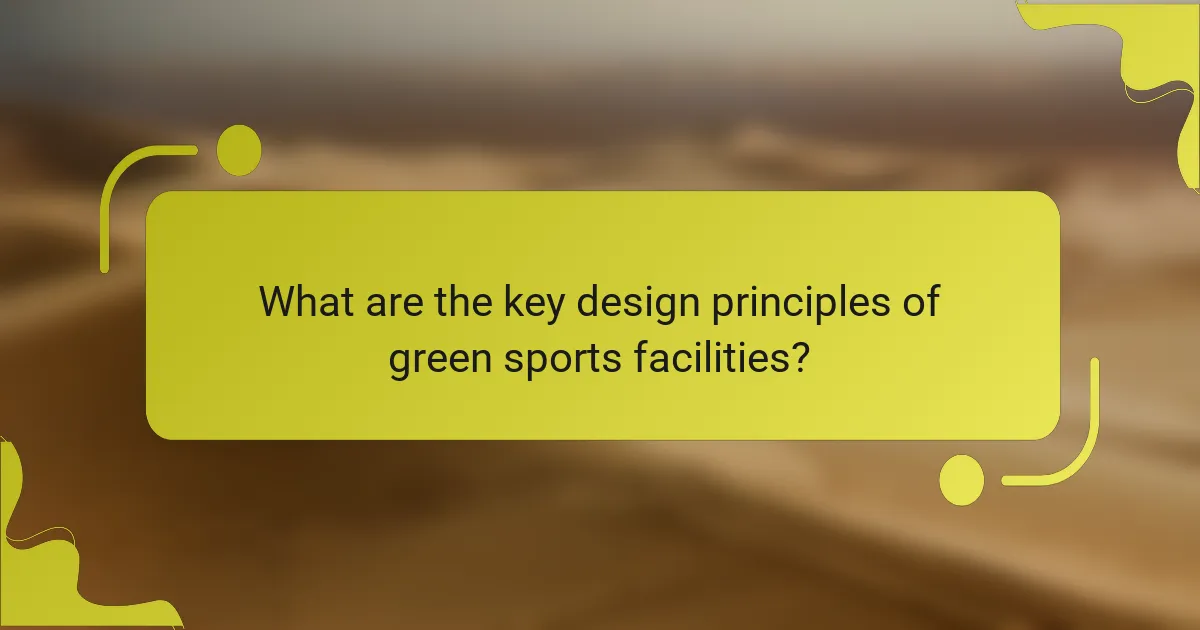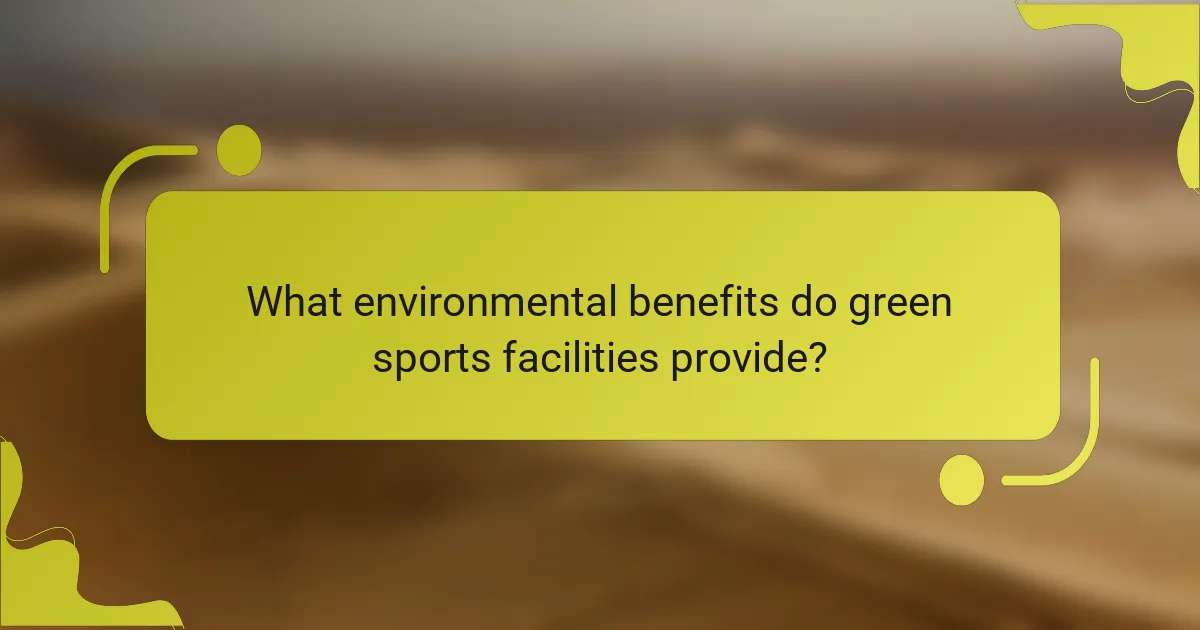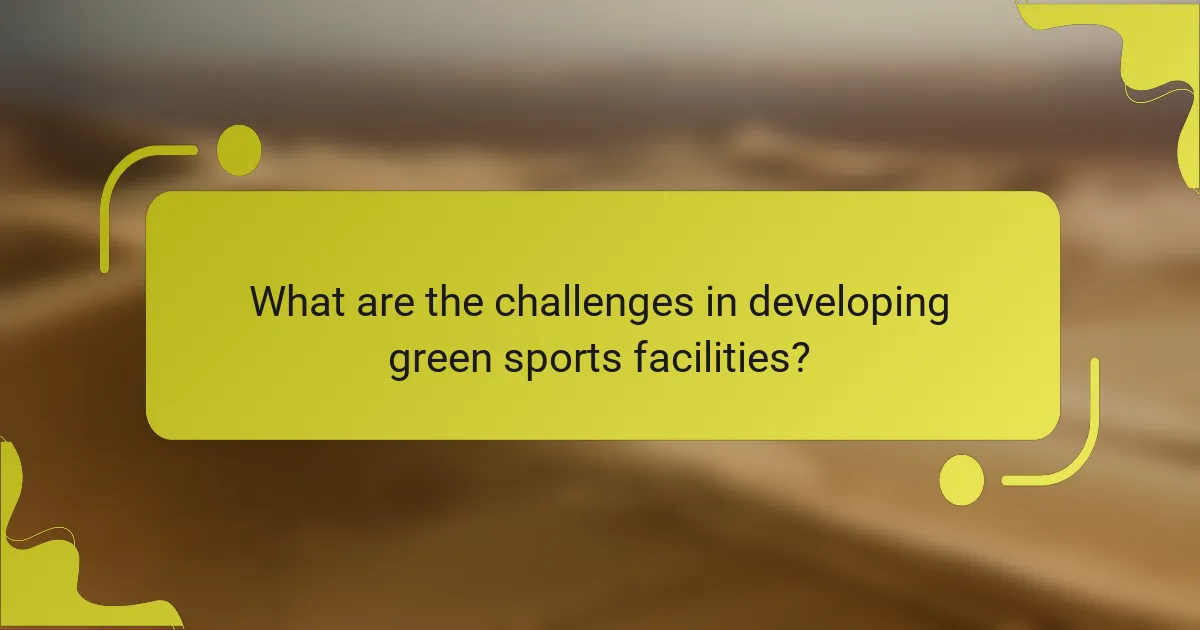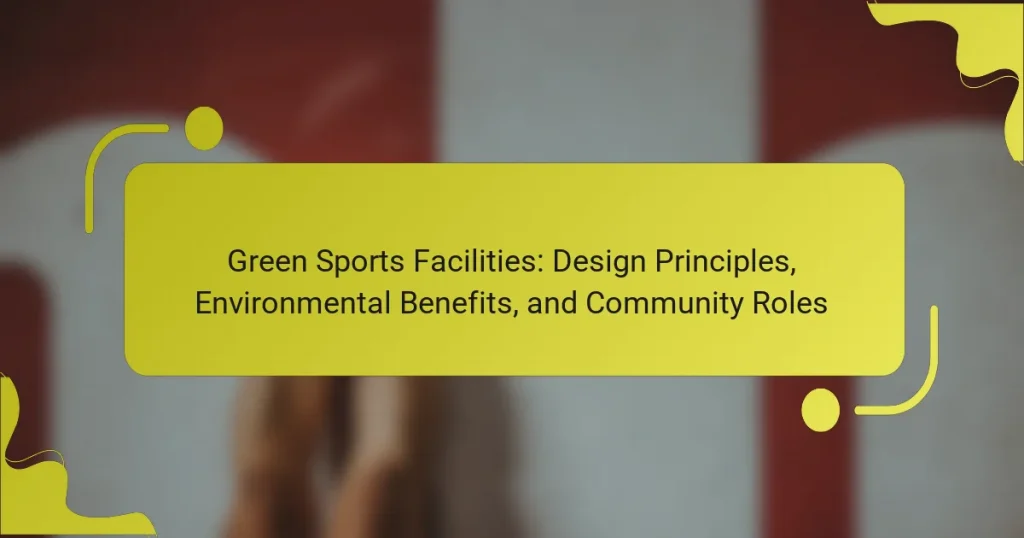Green sports facilities offer significant environmental benefits while promoting community engagement and health. Key design principles include sustainability, energy efficiency, and the use of renewable energy sources. These facilities enhance air quality and biodiversity through eco-friendly materials and innovative technologies. Community roles are emphasized by providing accessible spaces and programs that foster local participation and well-being.

What are the key design principles of green sports facilities?
Key design principles of green sports facilities include sustainability, energy efficiency, and community engagement. These facilities prioritise renewable energy sources, water conservation, and environmentally friendly materials. They incorporate features like natural ventilation and green roofs to enhance energy efficiency. Community roles are emphasised through accessible spaces and programs that promote health and wellness.
How does sustainable architecture influence facility design?
Sustainable architecture significantly enhances facility design by prioritising environmental efficiency and community engagement. It reduces energy consumption, utilises renewable materials, and promotes biodiversity. Green sports facilities often incorporate features like natural ventilation and rainwater harvesting, which contribute to lower operational costs and a smaller carbon footprint. These designs foster a sense of community by providing inclusive spaces that encourage participation in sports and wellness activities.
Which materials are most commonly used in eco-friendly construction?
Common materials used in eco-friendly construction include bamboo, recycled steel, rammed earth, straw bales, and reclaimed wood. These materials contribute to sustainability by reducing waste and lowering carbon footprints. Bamboo is a rapidly renewable resource, while recycled steel minimises the need for new mining. Rammed earth provides excellent thermal mass, and straw bales offer effective insulation. Reclaimed wood enhances aesthetics and reduces deforestation.
What role does energy efficiency play in facility design?
Energy efficiency is crucial in facility design as it reduces operational costs, minimises environmental impact, and enhances user experience. Implementing energy-efficient systems, such as LED lighting and advanced HVAC, significantly lowers energy consumption. For example, green sports facilities can achieve up to 40% energy savings compared to traditional designs. This commitment to efficiency not only supports sustainability goals but also positions facilities as community leaders in environmental responsibility.
How can water conservation strategies be integrated?
Integrating water conservation strategies in green sports facilities involves implementing efficient irrigation systems, utilising rainwater harvesting, and promoting drought-resistant landscaping. These methods minimise water usage while maintaining facility aesthetics and functionality.
Efficient irrigation systems can include smart controllers that adjust watering schedules based on weather conditions. Rainwater harvesting captures and stores rainwater for irrigation and non-potable uses, reducing reliance on municipal water sources. Drought-resistant landscaping incorporates native plants that require less water, enhancing biodiversity and reducing maintenance costs.
By adopting these strategies, facilities can significantly lower their water consumption, contributing to environmental sustainability and resilience against climate change.
What are the benefits of natural lighting in sports facilities?
Natural lighting in sports facilities enhances athlete performance, reduces energy costs, and improves spectator experience. It promotes well-being by providing natural circadian rhythms and increasing mood. Facilities with ample natural light can achieve up to 30% energy savings compared to those relying solely on artificial lighting. Additionally, natural light fosters a connection to the outdoors, enhancing the overall aesthetic appeal of the facility.

What environmental benefits do green sports facilities provide?
Green sports facilities provide significant environmental benefits, including reduced energy consumption and improved air quality. They utilise sustainable materials and incorporate renewable energy sources, such as solar panels. These facilities often feature green roofs and natural landscaping, which enhance biodiversity and manage stormwater effectively. Additionally, they promote sustainable transportation options, encouraging walking, biking, and public transit use.
How do these facilities contribute to carbon footprint reduction?
Green sports facilities significantly reduce carbon footprints through sustainable design and energy-efficient operations. They utilise renewable energy sources, such as solar and wind, minimising reliance on fossil fuels. Additionally, these facilities often incorporate green roofs and energy-efficient building materials, which enhance insulation and reduce energy consumption. Community engagement in sustainability initiatives further amplifies their impact, fostering a culture of environmental responsibility.
What impact do green sports facilities have on local biodiversity?
Green sports facilities positively impact local biodiversity by creating habitats, enhancing ecosystem services, and promoting sustainable practices. These facilities often incorporate native vegetation, which supports local wildlife and improves soil health. For example, green roofs and rain gardens provide essential resources for pollinators and other species. Additionally, these spaces can serve as educational platforms, raising awareness about environmental conservation within the community. Overall, green sports facilities foster a connection between sports and nature, contributing to biodiversity preservation.
How can they enhance air quality in urban areas?
Green sports facilities enhance air quality in urban areas by incorporating natural elements and sustainable design principles. These facilities utilise vegetation, such as trees and plants, to absorb pollutants and improve oxygen levels. Green roofs and walls further reduce heat and filter air, promoting healthier environments. Community engagement in maintaining these spaces fosters awareness of environmental issues and encourages collective responsibility for air quality.

How do green sports facilities engage with the community?
Green sports facilities engage with the community by promoting sustainability, fostering health, and providing recreational opportunities. They often host events that educate on environmental issues, encouraging local participation. These facilities utilise eco-friendly designs that enhance community pride and well-being. Collaborations with schools and organisations further strengthen community ties, making sports accessible and inclusive.
What programs can be implemented to promote community involvement?
To promote community involvement in green sports facilities, implement programs that engage local residents in decision-making and activities. Initiatives like community design workshops, volunteer days for facility maintenance, and educational events on sustainability foster participation. These programs enhance community ownership and awareness of environmental benefits.
How do these facilities support local economies?
Green sports facilities support local economies by creating jobs, attracting tourism, and enhancing community engagement. These facilities often generate employment opportunities in construction, maintenance, and event management. For example, hosting sports events can draw visitors, boosting local businesses such as hotels and restaurants. Additionally, they promote community involvement through accessible programs and activities, fostering a sense of belonging and pride. Ultimately, the investment in green sports facilities contributes to sustainable economic growth and improved quality of life for residents.
What are the social benefits of accessible green sports spaces?
Accessible green sports spaces enhance social cohesion, promote inclusivity, and support community health. These facilities encourage physical activity, fostering connections among diverse groups. They provide safe environments for recreation and social interaction, reducing isolation. As a result, communities experience improved mental well-being and stronger social networks.

What are some innovative examples of green sports facilities worldwide?
Innovative examples of green sports facilities worldwide include the Mercedes-Benz Stadium in Atlanta, which features a rainwater collection system and solar panels. The Eco Park in Singapore integrates natural ventilation and green roofs. The Allianz Arena in Munich utilises energy-efficient lighting and a unique facade that reduces heat. The National Stadium in Beijing employs a rainwater harvesting system and energy-efficient technologies. The Levi’s Stadium in California has a zero waste goal and uses renewable energy sources. The London 2012 Olympic Park incorporated sustainable materials and biodiversity initiatives.
Which facilities have achieved notable sustainability certifications?
Several green sports facilities have achieved notable sustainability certifications, including LEED, BREEAM, and ISO 14001. Examples include the Mercedes-Benz Stadium in Atlanta, which received LEED Platinum certification, and the Barclays Center in Brooklyn, recognised for its BREEAM rating. These certifications reflect their commitment to sustainable design and environmental stewardship. Other facilities, like the Levi’s Stadium in California, have also achieved LEED Gold status, highlighting their energy-efficient practices and community engagement.
How do design features vary across different regions?
Design features of green sports facilities vary significantly across regions due to climate, culture, and community needs. In temperate climates, facilities often incorporate natural ventilation and rainwater harvesting systems. In arid areas, drought-resistant landscaping and solar energy systems are common. Urban facilities may focus on multi-use spaces and accessibility, while rural designs might emphasise sustainability and integration with nature. Local regulations and community involvement also influence design choices, ensuring facilities meet specific regional requirements and promote environmental stewardship.

What are the challenges in developing green sports facilities?
Developing green sports facilities faces challenges such as high initial costs, regulatory hurdles, and limited access to sustainable materials. These factors can impede the adoption of eco-friendly design principles.
High upfront investments deter stakeholders, as they often prioritise short-term financial returns. Regulatory frameworks may lack support for innovative green technologies, complicating compliance. Additionally, sourcing sustainable materials can be difficult due to market availability and supply chain issues.
Community engagement is essential yet challenging, as varying interests can lead to conflicting priorities. Educating stakeholders about the long-term benefits of green facilities is crucial for overcoming resistance and fostering support.
What financial considerations must be addressed during construction?
Financial considerations during construction of green sports facilities include budget planning, sustainable material costs, and long-term operational expenses. Initial investments in eco-friendly technologies may be higher but often lead to savings through energy efficiency. Additionally, funding sources such as grants and community partnerships can enhance financial viability. Evaluating lifecycle costs is essential to ensure that the facility remains economically sustainable over time.
How can regulatory hurdles be navigated?
Regulatory hurdles can be navigated by engaging stakeholders early and understanding local laws. Collaboration with regulatory bodies ensures compliance and promotes sustainable practices in green sports facilities. Continuous education on environmental standards helps facilities adapt to changing regulations. Regular audits can identify potential issues before they arise.
What are common misconceptions about green sports facilities?
Many misconceptions exist about green sports facilities, primarily regarding their cost, effectiveness, and design. Some believe that green facilities are prohibitively expensive to build and maintain, while studies show they often lead to long-term savings through energy efficiency. Others think that these facilities compromise performance, but they can enhance player experience by providing better air quality and comfort. Additionally, people may assume that green design is only for elite venues, ignoring the community benefits these facilities offer, such as promoting sustainability and engaging local populations.

What future trends are emerging in green sports facility design?
Emerging trends in green sports facility design focus on sustainability, community engagement, and advanced technology. Facilities increasingly incorporate renewable energy sources, like solar panels, to reduce carbon footprints. Biophilic design elements enhance natural light and ventilation, promoting athlete well-being. Water conservation systems, such as rainwater harvesting, improve resource efficiency. Smart technologies optimise energy use and enhance user experiences. Community involvement in planning fosters inclusivity and supports local ecosystems.
How is technology shaping the evolution of these facilities?
Technology is significantly enhancing the design and functionality of green sports facilities. Innovations like energy-efficient lighting and smart water management systems reduce environmental impact. Advanced materials, such as recycled plastics and sustainable wood, improve durability while promoting eco-friendly practices. Integration of renewable energy sources, like solar panels, supports energy independence and lowers operational costs. Additionally, technology facilitates community engagement through interactive designs and sustainable event management systems, fostering a stronger connection between facilities and their local populations.
What role do community feedback and participation play in future designs?
Community feedback and participation are crucial for designing green sports facilities. They ensure the designs meet local needs and enhance environmental sustainability. Engaging the community fosters a sense of ownership and encourages support for eco-friendly initiatives. Feedback can highlight unique local attributes, such as specific environmental concerns or cultural values, leading to more effective and accepted designs. As a result, facilities can achieve greater success in promoting community health and environmental awareness.
Which upcoming innovations could redefine green sports facilities?
Innovations in green sports facilities include advanced materials, energy-efficient technologies, and sustainable landscaping practices. These advancements aim to minimise environmental impact and enhance community engagement. Smart building systems can optimise energy use, while rainwater harvesting systems improve resource efficiency. Additionally, incorporating green roofs and solar panels can significantly reduce carbon footprints. Emphasising local materials fosters community involvement and supports regional economies.
What best practices can be adopted for optimizing green sports facilities?
To optimise green sports facilities, adopt practices that enhance sustainability and community engagement. Implement energy-efficient designs, utilise renewable materials, and incorporate natural landscaping.
1. Use solar panels to reduce energy consumption.
2. Implement rainwater harvesting systems for irrigation.
3. Choose sustainable building materials with low environmental impact.
4. Design multi-use spaces to increase community access and participation.
5. Conduct regular environmental impact assessments to identify improvement areas.




